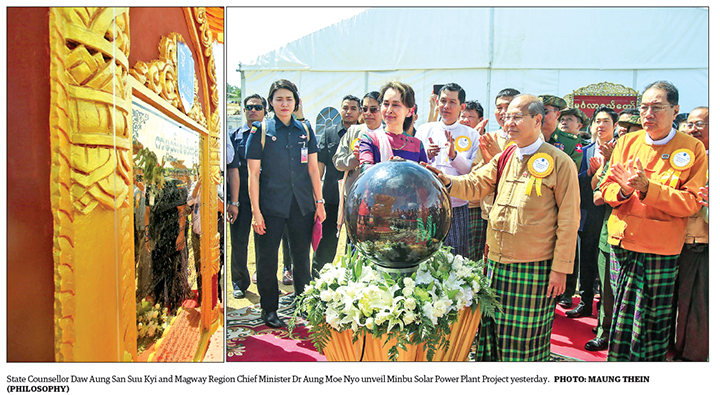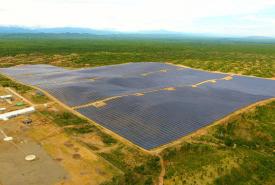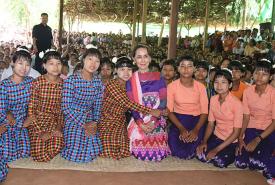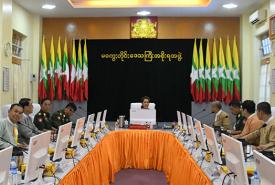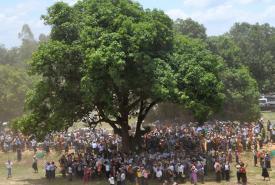State Counsellor Daw Aung San Suu Kyi inaugurated the first phase of a solar power plant project in Minbu yesterday, adding 40MW of power generated by the plant’s first phase to the national grid.
Once completed, the plant will have a total capacity of 170MW, and it will produce 350 million kWh (kilowatt hour) per annum, and electrify about 210,000 households.
State Counsellor Daw Aung San Suu Kyi, the Chairperson of the Central Committee for Development of Border Areas and National Races together with Union Ministers Lt-Gen Kyaw Swe, Lt-Gen Ye Aung, U Min Thu, U Ohn Win and officials arrived at Magway from Nay Pyi Taw yesterday morning.
The State Counsellor and party were welcomed at Magway Airport by Magway Region Chief Minister Dr Aung Moe Nyo, region ministers, Hluttaw representatives and officials.
From there the State Counsellor and party proceeded to the Minbu Solar Energy Power Plant Project 16 miles 3 furlong southwest of Minbu (Saku) Town by Tatmadaw helicopters and were greeted upon arrival by Region Hluttaw Speaker U Tar, Deputy Minister Dr. Tun Naing and officials.
State Counsellor Daw Aung San Suu Kyi then met with the local people of Minbu (Saku) region and officials at the temporary briefing hall where the opening ceremony of Minbu Solar Power Plant Project was held.
At the meeting the State Counsellor said that the Minbu Solar Power Plant Project was the first commercial solar power plant in Myanmar. It was implemented under BOT system by Green Earth Power (Myanmar) Co., Ltd. Installed capacity was 170 MW and the project would be conducted in four stages. First to third stage was to construct 40 MW each of generating power and the fourth stage would construct 50 MW generating power. Once the entire 170 MW generating power was constructed, it would produce 350 million kWh (kilowatt hour) per annum distributing electricity to about 210,000 households.
Today’s opening ceremony was for the implementation of the construction for the first stage 40 MW started on 4 February 2018. The electricity generated from the first stage 40 MW was being transmitted to the national grid via 230 KV Mann-An power line.
Solar power stations had the drawbacks of requiring wide land area to construct the station, dependent on weather, high cost of electricity and high cost of battery storage but the solar energy required to generate the electricity was an ever available renewable energy. However it does not need fuels such as diesel, gas and coal required by other power stations. It had many advantages such as low maintenance cost, reduces carbon dioxide emission, obtain technology development and very low emission of products that causes environmental pollution. It was expected that as technology advanced, more weaknesses would be removed.
Myanmar needed the spirit of continuous innovation and invention. Development must be conducted according to natural surroundings and environmental situation. Even though there were weaknesses in solar energy power plants, all power generating systems had strengths and weaknesses. All had to be considered and the best was to be selected. As climate changes, hydropower system were noted to be not always reliable. Therefore, as the situation changes, it was very important for us to have the ability and courage to change our technology.
After our government took over responsibility, from 2016 April to 2019 March, the progress of electrical power sector in Magway Region was a 40 MW hydro power station (Myittha) that distributes power starting from 9 January 2017. On new power lines 100 miles of 230 KV power line, 236 miles of 66 KV power line, 10 miles of 33 KV power line, 557 miles of 11 KV power line and 191 miles of 400 Volt power lines were laid. On sub-stations 66 KV sub-station with 446 MVA installed capacity, 33 KV sub-station with 143 MVA installed capacity and 11/0.4 KV sub-station with 98 MVA installed capacity were installed. Due to this electricity was provided to 7 towns of Gangaw, Htilin, Saw, Kyaukhtu, Kyaw, Mindon and Kamma and 317 villages totaling 68,149 households.
The Union government was placing great emphasis towards providing electricity to all the people in the country 100 per cent and to raise the socio-economic condition of the people by upgrading state-own power station, constructing state-own power stations, expanding the construction of sub-stations and the laying of power lines with own fund, foreign loan and assistances every year in stages. While doing this, it was implementing new project like the present one under BOT system as privately owned projects with foreign investment.
In striving towards achieving the targeted electricity generating capacity, huge power station with high installed generating capacity, mid-level power stations and mini-power stations were being implemented based on investment and economic viability of privately owned power stations.
While hydropower stations with long construction periods were under construction, solar power stations with short construction period like the current one would be constructed after careful consideration to provide electricity.
In an effort to distribute electricity to all over the country, 746 MW was generated from all energy sources during the period 2016 to 2018. From the start of 2019 to June a new natural gas and solar power stations generating 393 MW were completed. To improve services to the public, the public was given a choice of four types of meters starting from early April 2018 while only one type was offered in the past.
The government provided round the clock power to 68 towns and 5,191 villages during the 3 year period. In 2016 electricity utilization was just 34 per cent and it was increased to 44 per cent now. Arrangements were made for electricity utilization to reach 50 per cent of the country by December 2019.
It was true that some had complained about frequent black outs after getting electricity. But there were many reasons for this. They were investigating to find out the reasons and would strive toward preventing recurrences in the future.
While the government was striving towards providing stable electricity, it would also strive towards providing electricity to those who did not have access to it. Arrangements were made to provide electricity to 55 per cent of the country in 2021, 75 per cent of the country in 2025-2026 and 100 percent or the whole country by 2030. Arrangements were also made to provide a timely short-term provision of about 1,200 MW with LNG and gas fired engines.
We were using many ways to obtain electricity and we could not depend on a single way or method. If we depended on a single way or method we would not be able to meet the requirements of the country.
The country’s development and raising the living standard of the people was directly related to increasing electric power generation. Our government would continue its effort to achieve the aim of providing electricity to 100 per cent of the country. At the same time, the people were urged to cooperate and support the government’s implementation efforts, said the State Counselor.
Next the Region Chief Minister explained about the status of acquiring and using electricity in Magway Region.
Afterwards, Green Earth Power (Myanmar) Co., Ltd showed a video record of the project works, after which Region Hluttaw representative U Kyaw Swan Yee spoke words of thanks.
State Counsellor Daw Aung San Suu Kyi then took a commemorative group photo with meeting attendees and attended that open ceremony of the Minbu Solar Power Plant Project. The ceremony was opened by Region Hluttaw Speaker U Tar, Deputy Minister Dr Tun Naing, Region minister U Myint Zaw, Hluttaw representatives and officials cutting the ceremonial ribbon.
The State Counsellor and Region Chief Minister also unveiled the plaque commemorating the opening ceremony of the Minbu Solar Power Plant Project by pressing a button and sprinkled scented water onto the plaque.
Afterwards, State Counsellor Daw Aung San Suu Kyi observed generation of electricity with solar power from the view point.
From there, the State Counsellor and party went by Tatmadaw helicopters to a meeting with local people in a temporary pandal at Pwintbyu Township, Yaypotegyi Village Tract, Yaypotegyi Village.
At the meeting, the State Counsellor urged parents to raise the education level of their children so that the children who were learnt to be attending school only to fourth grade could complete their education. Questions raided by the State Counsellor on education, health, agriculture, road transport and acquisition of potable water in Yaypotegyi Village Tract were explained by the locals and officials. The State Counsellor provided guidelines on practical works that could be conducted.
The State Counsellor and Region Chief Minister also responded to questions raised by the local people.
Later, the State Counsellor accepted K 7.5 million to provide potable water to Yaypotegyi Village, K 5 million to repair village road and K 20 million to repair Sedaw Village School donated by U Aye Zaw and wife Daw Su Su Zin and K 5 million donated by Dr Khin Thu Zar Kyaw family to repair village road. The donated monies were then transferred to village administrator by the State Counsellor.
After this, State Counsellor Daw Aung San Suu Kyi took a commemorative group photo with local residents and youth and observed the Shwe Nyar Myay photo exhibition.
Yaypotegyi Village was known as a village that maintains traditional hairstyle. This traditional hairstyle has been maintained ever since the village came to existence.
After the meeting, the State Counsellor paid homage to the Yaypotegyi Village monastery principal patron Sayadaw Bhaddanta Wunnathara and made donations.
The State Counsellor left Yaypotegyi Village by Tatmadaw helicopter and reached Magway where she met with Magway Region government members in Magway Region Government meeting hall.
Later in the evening, State Counsellor Daw Aung San Suu Kyi and the party left Magway by special flight and arrived back in Nay Pyi Taw. — MNA
(Translated by Zaw Min)
